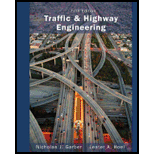
Concept explainers
The expected reductions inthe number of crashes during the first three years after implementation of the countermeasures.
Answer to Problem 23P
The expected reductions in number of crashes during the first three years after implementation of the countermeasures are
Explanation of Solution
Given:
The number of countermeasures is
The countermeasure factors
The number of crashes per year at the identified intersection during the past three years are
The average annual daily traffic
The average annual daily traffic
The estimated traffic growth rate per annum after implementation is
Formula used:
The crash reduction factor is given by,
Here,
The average number of crashes per year is given by,
The
The crashes prevented first year is given by,
Here,
The crashes prevented second year is given by,
The crashes prevented third year is given by,
Calculation:
Substitute
Substitute
Substitute
Substitute
Substitute
Substitute
Conclusion:
Therefore, theexpected reductions in number of crashes during the first three years after implementation of the countermeasures are
Want to see more full solutions like this?
Chapter 5 Solutions
Traffic And Highway Engineering
- b) What are the three májor c) The Zambian Road Transport and Safety Agency (RTSA) has established crash reduction factors shown in the table below. Countermeasure Reduction Factor 0.10 Retime signals Provide left-turn signal phase Reduce speed limit on approaches Provide turning guide lines Prohibit left turns 0.30 0.35 0.05 0.75 An intersection has been identified as having an abnormally high left-turn crash rate (17, 20, and 18 crashes in the last three years), attributed to excessive speeds and the absence of an exclusive left-turn phase. The ADT of the intersection for the last three years is 8400, and the ADT for after implementation is 9500. Determine: the appropriate countermeasures and ii. the expected reduction in crashes if the countermeasures a you have proposed are implemented. i.arrow_forwardWhat are the major types of data that are needed for freeway congestion management? Emphasize on recurrent, non-recurrent, and emergency-event induced freeway congestion.arrow_forwardCivil Engineering The number of accidents has been recorded at an intersection in the last three years as follows: 18, 21, and 19. The accidents were mostly due to left-turning vehicles, speeding, and the absence of left-turn protection. The average ADT for the last 3 years is 8500. The following shows the crash reduction factor for various countermeasures: Reduction Factor Countermeasure Retime signals Provide left-turn signal phase Reduce speed limit on approaches Provide turning guide lines Prohibit left turns 0.10 0.30 0.35 0.05 |0.75 a) Determine the appropriate countermeasures b) Determine the expected reduction in crashes if the countermeasures are implemented. The ADT is expected to increase 2% Neat work pleasearrow_forward
- A 2-mile long section of a roadway has recorded 20 crashes (total) during a period of 5 years. What is the crash rate for the section in terms of rate per 100 million entering vehicles?arrow_forwardFind the crash frequency and crash rate of the following: Road Segment A: A three-mile section of road that has had four crashes over five years and has a traffic volume of 5,500 vehicles per day. Road Segment B: A three-mile section of road that has had 10 crashes over five years and has a traffic volume of 18,000 vehicles per day.arrow_forward1. With the new highway interchange at a dangerous street intersection, police records indicate an average of 5 accidents per month. The Department of Traffic Safety wants to investigate the probability of the following occurring in any month:a) No more than 4 accidents.c) At least 2 accidents.b) A single accident.d) At most 2 accidents in 15 days.arrow_forward
- Problem 5 The crash rate on a heavily-traveled two-lane rural highway is abnormally high. The corridor is 14 miles long with an AADT of 34,000. An investigation has determined that head-on collisions are most common, with an RMVMT of 4.5, and are caused by vehicles attempting to pass. Addition of a passing lane has been observed as an appropriate countermeasure with a CMF of 0.65. Calculate the estimated yearly reduction in total crashes.arrow_forwardThe crash rate on a heavily traveled two-lane rural highway is abnormally high. Thecorridor is 14 miles long with an ADT of 34,000. An investigation has determined thathead-on collisions are most common with an RMVMT of 4.5 and are caused by vehicles attempting to pass. Determine an appropriate countermeasure and calculate theestimated yearly reduction in total crashes.arrow_forward22. An intersection had 25 reported traffic crashes during the months of January through September. The AADT for the intersection is shown. What is the crash rate per million entering vehicles 2000 8000 4000arrow_forward
- A state transportation agency want to evaluate engineering countermeasures applied to a two-lane,two-way rural highway segment.This 4 miles segment has been identified as having 14,19,and 23 total crashes in the last three years,before the implementation of the countermeasures.The AADT at the segment for last three years is 5630 vehicles per day and the AADT for after implementation is 6240 vehicles per day.Compute the expected average crash frequency for the after period, assuming the treatment was not implemented.The segment has the same conditions as the base conditions established for SPF.arrow_forwardDetermine the predicted average crash frequency, in crashes (per year), on a 7-mile segment of a rural divided multilane highway with 10-ft lanes and 8-ft paved shoulders that carries an AADT of 15,000 vehicles per day. The proportion of total crashes constituted by CMF-related crashes is 0.55.arrow_forward10.A lane on a freeway displays the following characteristics: (a) average headway between vehicles is 1.9s, and (b) the average spacing between vehicles is 210 feet. What is the rate of flow for the lane? What is the average speed in mi/hr? 11. Define 'Crash Modification Factor (CMF)" and describe how one might be used by a transportation agencyarrow_forward
 Traffic and Highway EngineeringCivil EngineeringISBN:9781305156241Author:Garber, Nicholas J.Publisher:Cengage Learning
Traffic and Highway EngineeringCivil EngineeringISBN:9781305156241Author:Garber, Nicholas J.Publisher:Cengage Learning
